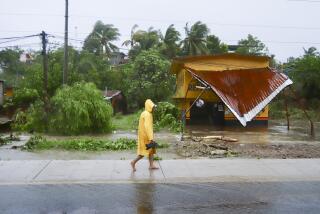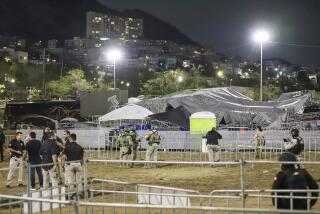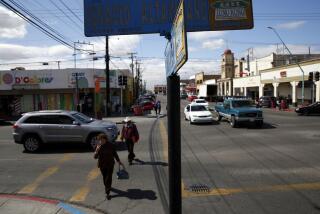Big Aftershock Rocks Mexico; Toll at 2,000 : New Quake Is 7.3; Rescuers Comb Rubble
- Share via
MEXICO CITY — A violent aftershock struck this quake-devastated city Friday night, damaging more buildings, driving terrorized residents back into rubble-strewn streets and intensifying the level of tragedy.
The second quake came as the Mexican government was raising the official death toll in Thursday’s quake to 2,000. About 1,300 people were confirmed dead in Mexico City alone, and the steady discovery of bodies in collapsed buildings pointed to many more dead. Government officials estimated that the final nationwide toll might top 3,000.
“I would not dare give a number,” Mexico City Mayor Ramon Aguirre Velazquez said grimly. Late Thursday, Aguirre had estimated that at least 1,000 people were still buried in the wreckage of the hotels, business buildings and apartment houses brought down by the force of temblor.
The aftershock, which rumbled through southern Mexico at 7:37 p.m. (6:37 p.m. PDT), qualified as a major earthquake on its own. It registered 7.3 on the Richter Scale, according to the U.S. Geological Survey in Golden, Colo., and hit just as Mexican officials and many residents had begun to think the worst was over after the devastating quake that struck Thursday morning.
Several newspapers here Friday had quoted experts who said that a major aftershock was unlikely. Dozens of aftershocks, but none worse than 4.8 on the Richter Scale, had previously been recorded since the Thursday quake, which, at 7.8, was the worst temblor to hit Mexico in a decade.
The epicenter of the new quake was reported to be about the same place as Thursday’s, 200 miles west of Mexico City.
It was not immediately known how much damage and new loss of life might have been wrought by the aftershock. The new quake seemed to start slowly, then over a period of about a minute built up to a fierce frenzy. Lights went out in many sections of the capital, and more debris spilled into the streets as floors of hotels and offices buckled.
Charles Carpenter, a Pedley, Calif. ham radio operator, was on the air to a Mexico City-area ham when the second quake hit. “He said, ‘Hold on a minute, there’s a big one coming,”’ Carpenter said. “All he could say was, ‘It’s a big one . . . stand by.’ Then, a moment later, the Mexican man said, ‘The earthquake is still going on. God bless us all,’ and that was the last time we heard from him. It makes me worry.”
5,000 Injured
The mayor said an estimated 5,000 people have already been treated for injuries.
Chaos and confusion pervaded the entire quake region. No one seemed to have a solid estimate of how much damage and how many deaths and injuries might eventually be counted, either in the capital or in the outlying towns and villages.
One official said about 35 people died in Jalisco state, northwest of Mexico City, though estimates Thursday had been much higher, and that 1,500 were injured. In Michoacan state, 30 people reportedly were killed in the collapse of two hotels in the beach resort of Playa Azul. The coastal town of Lazaro Gardenas was described as “semi-destroyed.”
Although damage in Guadalajara and Acapulco was relatively light, American tourists there were reported rushing to airports to fly home.
In Washington, State Department earthquake task force spokesman Greg Lagana said three Americans are known dead. They were identified as a woman, Mary Vallejo, and her two children. Vallejo was married to a Mexican citizen and had been living in Mexico City for some time, said John Adams, director of a State Department task force. “I understand she was in the street and was apparently struck by falling debris,” he said.
He said there were unconfirmed reports that an American couple was missing in one of the hotels that collapsed.
Ships Missing
Two merchant ships, five Mexican trawlers and two dozen small fishing boats were said to be missing in the Pacific Ocean about 135 miles west of Acapulco. The director of a special fishing fleet radio link in Spain said the Spanish crew on a Mexican fishing boat told of seeing 65-foot waves rise out of the ocean. The sea, a crewman reportedly said, “had gone wild.”
The missing ships were a Liberia-registered merchant vessel carrying 22 crewmen and a West German vessel carrying 11, according to Jesus Ferreiro of the radio link Onda Pesquera.
In Mexico City, where power was gradually being restored, bulldozers and cranes continued to struggle with the mountains of broken concrete so that more bodies could be pulled out of the debris.
Armed forces officials estimated that 100,000 military and civilian personnel had been mobilized in rescue efforts. But lack of equipment and fear of upsetting delicate mounds of rubble onto survivors within made rescue progress slow.
“Unfortunately, we are not capable of solving a problem of such magnitude,” said Col. Hector Fuentes, one of the officers in charge of the frantic rescue efforts.
Rescue units were ordered to concentrate on digging out the living instead of recovering cadavers.
Thousands of residents spent Thursday night out of doors in the glow of the unchecked fires, some with tents or makeshift shelters and others without. They were terrified of being caught inside weakened buildings, some on the verge of collapse. Temporary shelters were set up in offices and public buildings.
Families in search of missing relatives combed lists of the injured that were taped to hospital walls, while radio stations relayed messages from separated families.
Identification Deadlines
Makeshift morgues were established as bodies were retrieved from beneath jumbles of concrete slabs. Radio broadcasts warned the relatives of missing persons to report to government collection centers to identify the bodies of the dead. Deadlines were set: If no relatives appeared, the bodies would be burned.
Weeping children wandered through the torn streets in search of their parents. Adults called out the names of family members, sobbing as they went frantically from one rescue scene to the next.
A mother pleaded over Mexican television for her son. “I have been looking for my son since 9 o’clock yesterday morning,” she said. “His name is Alfonso Rodriguez. Please help me find him.”
One official said at least 250 “major” buildings were destroyed by the first quake. Before the second struck, another 90 were believed in danger of collapse, and 1,000 more suffered some damage. That, the official pointed out, did not include damaged or destroyed homes and small office structures.
Hardest hit in the capital city, whose population is estimated to be at least 18 million, were three large districts, the downtown sector around Plaza de la Constitucion, the eastside Tlatelolco district and a southern section around the national medical center.
Eight hospitals suffered severe damage or had entire wings collapse. At the downtown Mexico General Hospital, soldiers, medics and volunteers worked together, chipping away at the jumbled heap of concrete with jackhammers, picks and crowbars.
Between the layers of floors of the multi-story structure were, according to one rescue worker, more than 100 medical students and perhaps as many as 140 women in a maternity ward.
“There were 140 beds,” said a doctor. “It was full.”
At the same hospital, about 30 infants were found among the ruins. It was unclear how many survived.
1,000 Trapped
At the 13-story, government-built Nuevo Leon apartment complex in Tlatelolco, where three sections of the building crashed to the ground, officials said there may have been as many as 1,000 residents crushed in the first quake.
Skinny youths wearing surgical masks pulled out crushed and dismembered bodies. Many would be impossible to identify.
One family--a father with a baby in his arms, followed by his wife and daughter, emerged alive and ghostlike Friday from the debris. They were covered in dust.
“I don’t know how we survived,” said the dazed man. “We got under the table and prayed a lot.”
Near the smashed remains of Hotel El Romano, a Red Cross paramedic said 15 to 20 children had been rescued from the wreckage of a nursery school and four bodies had been removed.
Crews of men clawed Friday at the fiery debris of the shattered Hotel Regis on Avenida Juarez where, they said, they could hear screams but could not see the victims. At least 14 people were known to have died there.
A soldier outside the downtown Hotel Versalles, which collapsed on Thursday, said 23 dead and 18 injured had been removed during the night. He said another 100 people inside had not yet been found.
At the collapsed Principado Hotel, another worker said about 115 people were believed trapped inside.
The Mexican Tourism Ministry said that the other Mexico City hotels destroyed were the Monte Carlo, El Romano and the Castro.
Damaged Hotels
Damaged, with guests evacuated, were the Continental, the Presidente, the Zona Rosa, the Del Prado and the Alameda, the ministry said. The Maria Isbel, the Sheraton, the Holiday Inn and Crowne Plaza also sustained minor damage but guests were not forced out.
In the downtown district, ruptured natural gas lines still fed fires that had burned through the night. Firefighters were battling three major blazes. The Colonia Roma district was cordoned off because of gas leaks.
Radio stations carried frequent pleas for surgical instruments, blood, medical supplies and food as well as for picks and shovels to dig in the rubble.
Recriminations over the collapse of the building at Tlatelolco began to emerge. The city government was reported to be launching an investigation into the destruction of the low-cost apartment house, which was built by the National Popular Housing Development Office.
“Supposedly, 200 million pesos was invested in maintaining the building,” said Enrique Iron, a city official. “It seems not to have been well-invested.”
Oscar Calderon, a, private industrial engineer helping in the rescue, blamed the age of the building and poor maintenance for the disaster. “These buildings were properly built for their time,” he said of the 21-year old complex.
Fearful of Disease
Officials were also worried about the possibility of disease becoming the next horror to strike the city. Damage to the canal system reportedly caused flooding of Rio Piedad, an underground river that serves as the city’s sewage system.
Mayor Aguirre said it would take three or four days to restore water service.
American businessman Larry Rubin, who arrived in Dallas from the shattered Mexican capital, said many homes have their own water tanks, but noted that when they are empty there will be no water. “Unless something is done fast,” he said, “there are going to be big problems with typhoid and other epidemics.”
Efforts were being made to bury the bodies quickly to prevent pestilence.
Moans Heard in Rubble
Despite the constant sirens and the shouting of rescue workers, there could be heard the cries and moans of injured people still trapped in the jagged piles of broken concrete and webs of structural steel.
“Don’t give up, we are about to arrive,” firemen digging through a building on Revolucion Plaza. “Hold on.”
At least nine government buildings, including the Navy Ministry, the Finance Ministry, the Commerce Ministry and the Mexico City Police Department were destroyed but none of the city’s monuments or historic buildings was believed to have been seriously damaged. Officials said the Fine Arts Palace, the Angel of Independence monument and the cathedral were in good shape.
The last major earthquake to hit the capital was in 1957. That quake, which knocked over the Angel of Independence on Paseo de Reforma, left 52 dead and 569 injured.
Times staff writers Jack Jones and Patt Morrison in Los Angeles also contributed to this story.
More to Read
Sign up for Essential California
The most important California stories and recommendations in your inbox every morning.
You may occasionally receive promotional content from the Los Angeles Times.










